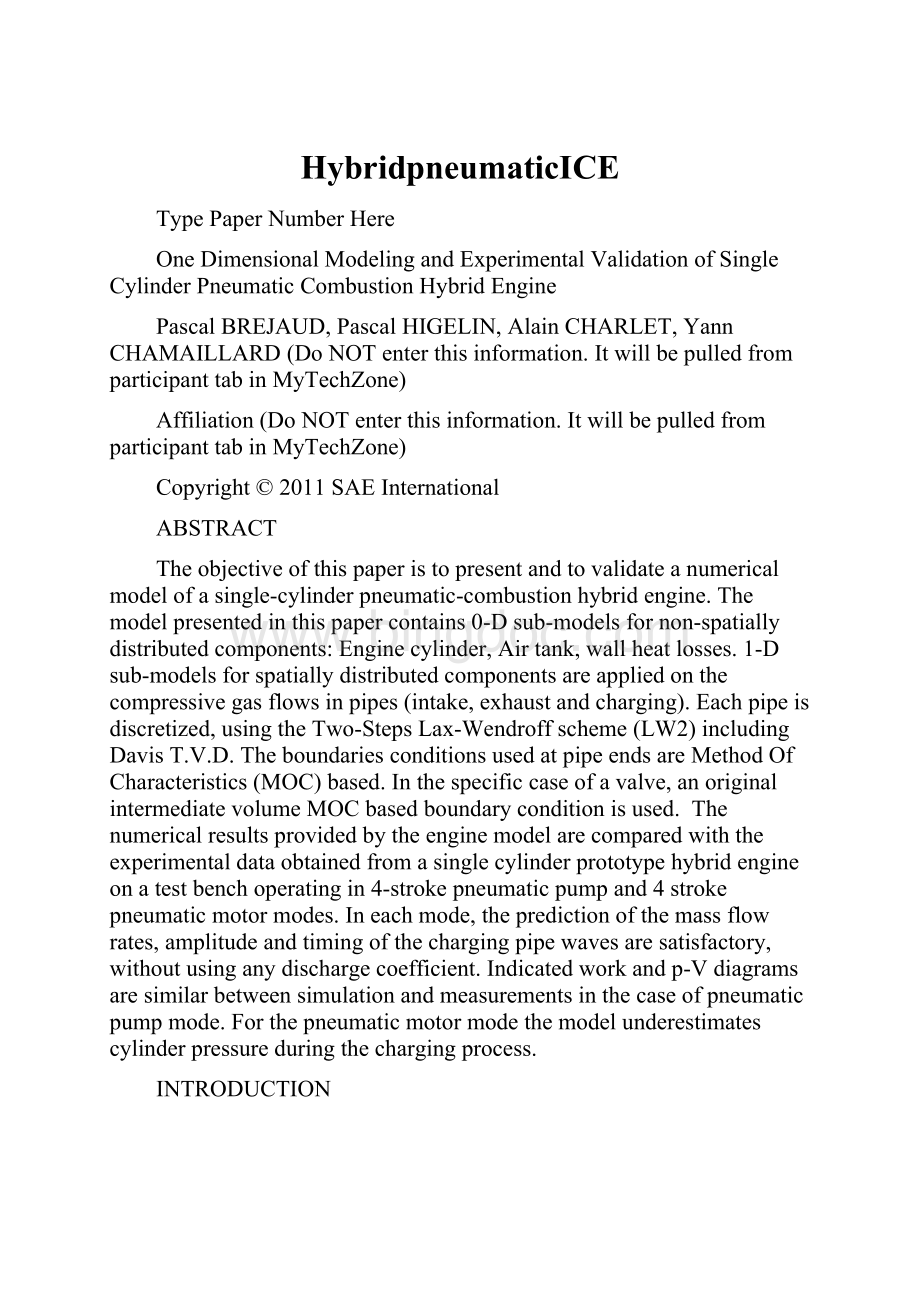HybridpneumaticICE.docx
《HybridpneumaticICE.docx》由会员分享,可在线阅读,更多相关《HybridpneumaticICE.docx(25页珍藏版)》请在冰点文库上搜索。

HybridpneumaticICE
TypePaperNumberHere
OneDimensionalModelingandExperimentalValidationofSingleCylinderPneumaticCombustionHybridEngine
PascalBREJAUD,PascalHIGELIN,AlainCHARLET,YannCHAMAILLARD(DoNOTenterthisinformation.ItwillbepulledfromparticipanttabinMyTechZone)
Affiliation(DoNOTenterthisinformation.ItwillbepulledfromparticipanttabinMyTechZone)
Copyright©2011SAEInternational
ABSTRACT
Theobjectiveofthispaperistopresentandtovalidateanumericalmodelofasingle-cylinderpneumatic-combustionhybridengine.Themodelpresentedinthispapercontains0-Dsub-modelsfornon-spatiallydistributedcomponents:
Enginecylinder,Airtank,wallheatlosses.1-Dsub-modelsforspatiallydistributedcomponentsareappliedonthecompressivegasflowsinpipes(intake,exhaustandcharging).Eachpipeisdiscretized,usingtheTwo-StepsLax-Wendroffscheme(LW2)includingDavisT.V.D.TheboundariesconditionsusedatpipeendsareMethodOfCharacteristics(MOC)based.Inthespecificcaseofavalve,anoriginalintermediatevolumeMOCbasedboundaryconditionisused.Thenumericalresultsprovidedbytheenginemodelarecomparedwiththeexperimentaldataobtainedfromasinglecylinderprototypehybridengineonatestbenchoperatingin4-strokepneumaticpumpand4strokepneumaticmotormodes.Ineachmode,thepredictionofthemassflowrates,amplitudeandtimingofthechargingpipewavesaresatisfactory,withoutusinganydischargecoefficient.Indicatedworkandp-Vdiagramsaresimilarbetweensimulationandmeasurementsinthecaseofpneumaticpumpmode.Forthepneumaticmotormodethemodelunderestimatescylinderpressureduringthechargingprocess.
INTRODUCTION
Figure1:
SchematicrepresentationofaSingleCylinder
Theconceptofthepneumatichybridengine
(1)
(2)isbasedonaconventionalinternalcombustionengineinwhichoneadditionalvalve,calledthechargingvalve,connectsthecombustionchambertoanairtank.SeeFigure1.Inordertoreducecosts,theintakeandexhaustvalveremaincamshaft-drivenandonlythechargingvalveismovedbyafullyvariableactuator(3).Asaresult,thenewmajormodesallowedbythisadditionalvalve(pneumaticpump,pneumaticmotorandsupercharged)remains4-Strokescycles:
∙PneumaticPump:
Thismodetransformsvehiclekineticenergyintoare-usablepneumaticenergy.Thecyclebeginswithaconventionalintakestroke.Thechargingvalveopensduringcompressionstrokesassoonasthein-cylinderpressurereachesthatofthechargingport.ThevalveclosesshortlyafterT.D.C,andthecyclefinisheswithconventionalexpansionandexhauststrokes.
∙PneumaticMotor:
Thismodeisusedtotransformpneumaticenergyintomechanicalworkwithoutanycombustion.Thecyclebeginswithclassicalintakeandcompressionstrokes.ThechargingvalveopenswhenapproachingTDC,andremainsopenduringpartoftheexpansionstrokeinordertomaintainpressureatahighlevelandgeneratethedesiredindicatedwork.Thecyclefinisheswithaconventionalexhauststroke.
∙PneumaticSuperchargedmode:
Thismodeisusedtocompensateforthe"turbolag"effect,whiletemporarilyboosttheengineduringastrongaccelerationtransient.Thechargingvalveopensshortlyafterintakevalveclosure,andcloseswhenthedesiredadditionalairmasshasflowedintothein-cylinder.Theendofthecycleremainsthesameasaconventionalfourstrokeone.
Severalpreviouspublications(4)(5)(6)haveshownthattheconceptofapneumatic-combustionhybridenginecouldprovidebenefitsintermsoffuelconsumptionandgreenhousegasemissionsthatarecomparablewiththoseofanelectrichybridvehicle(7)butwithlowerweightandpresumablylowercost(6).Toimprovetheperformanceandefficiencyofthehybridpneumaticconcept,thedevelopmentmainlyconsistsindeterminingthetimingofopeningandclosingofthechargingvalve,foragivenoperatingmode(pneumaticmotormode,pneumaticpumpmode,superchargedmode)andforagivenobjective(maximizationornominalcontrolofmechanicalwork,maximizationornominalcontrolofmassorenthalpytransferred,maximizationofglobalefficiencyetc.).Ithasbeenexperimentallyshown(8)thatlargeamplitudepressurewaves(near2barsofamplitude)arecreatedinsidethechargingpipeasaresultofthechargingvalveopeningandclosure.Inordertotakethispressurewavephenomenonintoaccounta1Dsimulationplatformisneeded.
However,thewayinwhichgastransferbetweenthecylinderandtheAirtankisperformeddependsonmanyparameters,suchas:
chargingpipelengthandcrosssection,airtankmeanpressure,airtanktemperature,chargingvalvehydraulicdiameterandnumber,chargingpiperoughness,chargingvalvelift.Thelargenumberofparameterstobeexploredforeachoperatingmodeandeachobjectivemakesoptimizationalmostimpossibletoperformexperimentally.Areliable,flexible,andfastnumerical1Dmodelisthereforeneededinordertodevelopcontrollaws.Twopreviousstudies(9)(10)haveuseda1-Dcommercialsimulationsoftwareforenginesimulations,butdonotpresentanycomparisonbetweenexperimentalandsimulatedresultsforwavetimingsandamplitude,massflowratesetc.Fromourpointofview,theuseofsuchcommercialcodeforapneumatichybridengineposesoneproblemandleavesonequestionunanswered.Theproblemisthatthesoftwarerequiresapreciseknowledgeofthedischargecoefficientversusliftofeachsimulatedvalve(11).Thesecoefficientarrayshavetobedeterminedbyexperimentsthusaprototypecylinderheadisrequired.Anestimateddischargecoefficientwillthereforebemoreorlesserroneous,leadingtoseriousdiscrepanciesbetweensimulationsandfuturemeasurements.Theunansweredquestionisthatthevalveboundaryconditionimplementedinthiskindofsoftwareisseldomvalidatedonpressureratiosashighasthoseencounteredinapneumatichybridengine(upto22).Tocircumventthepreviouspoints,authorshavedevelopedtheirownMOCvalveboundaryconditionthatobviatesinmanycasestheuseofaCoefficientofdischargeandhasbeenexperimentallyvalidatedonavalvegasdynamicstestbench(12).Theobjectiveofthepaperisnowtopresentthecompleteenginemodelthatembedsthisvalveboundarycondition,andtocompareexperimentsversussimulations.
Thepaperisorganizedasfollows:
Firstly,0Dcomponentsmodelsaredescribed:
thecylinderandtheairtankmodel.Secondly,the1Dsubmodelsforspatiallydistributedcomponentsaredescribed:
theLW2numericalschemeandthesimplifiedTVDschemeproposedbyDavisarepresented,followedbytheIntermediateVolumeValveboundarycondition.Thirdlytheresultsproducedbythecompletesinglecylinderhybridenginearepresentedandcomparedtomeasurementsobtainedwithaprototypeengine.
Quasi-dimensionalcomponentsoftheenginemodel
Airtank:
TheairtankthermodynamicstateshownonFigure1isdeterminedusingthefirstlawofthermodynamics:
Becausethetankhasaconstantvolume,
.AccordingtoJoule'slaw
with
thetemperatureofthegasescontainedintheTank.Theairtankisassumedtobeadiabatic,then
.Foraperfectgas,thespecificenthalpyisgivenby
with
thetemperatureoftheflowinggases.Finally,are-arrangementofEq.
(1)gives:
Theairflowmass
isdeterminedattheopenendboundary(seecorrespondingsectionofthispaper)usingthemethodofcharacteristics(M.O.C).Aclassicalnumericalintegrationthenprovidesthetotalairmassinsidethetank.UsingEq.
(2),theelementarytemperatureriseinthetankisdetermined.Applyinganumericalintegration,thenewtanktemperatureiscomputed.Finally,usingtheperfectgaslaw(pV=mrT),themeantankpressureisdetermined.
Enginecylinder
Thecylinderisthecentralpartofthesystem.Itexchangesheatandmasswiththeoutside.Itsthermodynamicstateisdeterminedusingthefirstlawofthermodynamics(Eq
(1)).
Wisthemechanicalworkgeneratedbythemovingwalls,Qisthetotalheat,mthemassandHistheenthalpy.Subscriptiindicatesanintakeflow,cindicatesachargingpipeflowandeindicatesanexhaustflow.Then:
Eachmassflowrateisdeterminedusingavalveboundarycondition(Seecorrespondingsectionofthispaper).Aclassicalnumericalintegrationtechniquethenyieldsthenewtotalmassinsidethecylinder.
Thetotalheat
isthesumofacombustionheat
andconvectiveheattransferthroughcylinderswalls
.
and
arerespectivelydeterminedusingtheWoshni(13)andWiebe(14)models.Theseclassicalcorrelationsarenotdetailedinthispaper.Re-arrangingEq
(1)finallygives:
Anumericalintegrationgivesthenewtemperatureofthecylinder.Thevolumeisdeterminedfromtheenginegeometryandcrankshaftposition(15).Thepressureisthencalculatedusingidealgaslaw.
One-dimensionalcomponentsoftheenginemodel
Fundamentals
Figure2:
ControlVolume
Flows,ineachpipe,areassumedtobemonodimensional.Theidealcompressivegasisassumedtobeinviscid.Threeconservationlawsarewrittenforacontrolvolume,respectivelythemass,momentumandenergy.Figure2showstheflowofanidealcompressiblegasthroughaninfinitesimalsectionofpipe.
and
arerespectivelythepressure,thedensity,thevelocity,thetime,thespaceandthecrosssectionarea.
Continuityequation:
Therateofchangeofmasswithinthecontrolvolumeisequaltonetmassflowratethroughtheelement.Thisprincipleleadsto(16)(17):
Momentumequation:
Therateofchangeofmomentumwithinthecontrolvolumeisequaltothesumoftheforcesappliedonthecontrolvolume.Inordertomodelthefrictionbetweentheflowandthewa